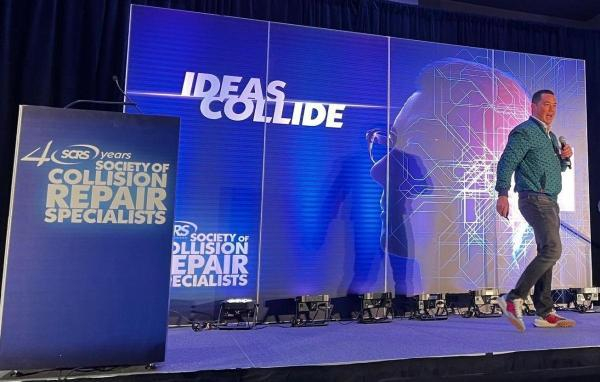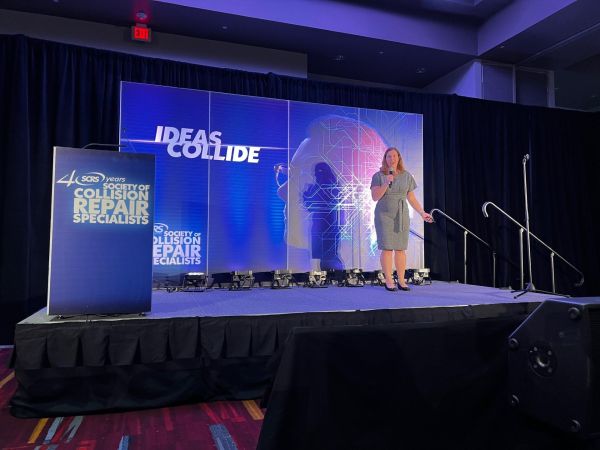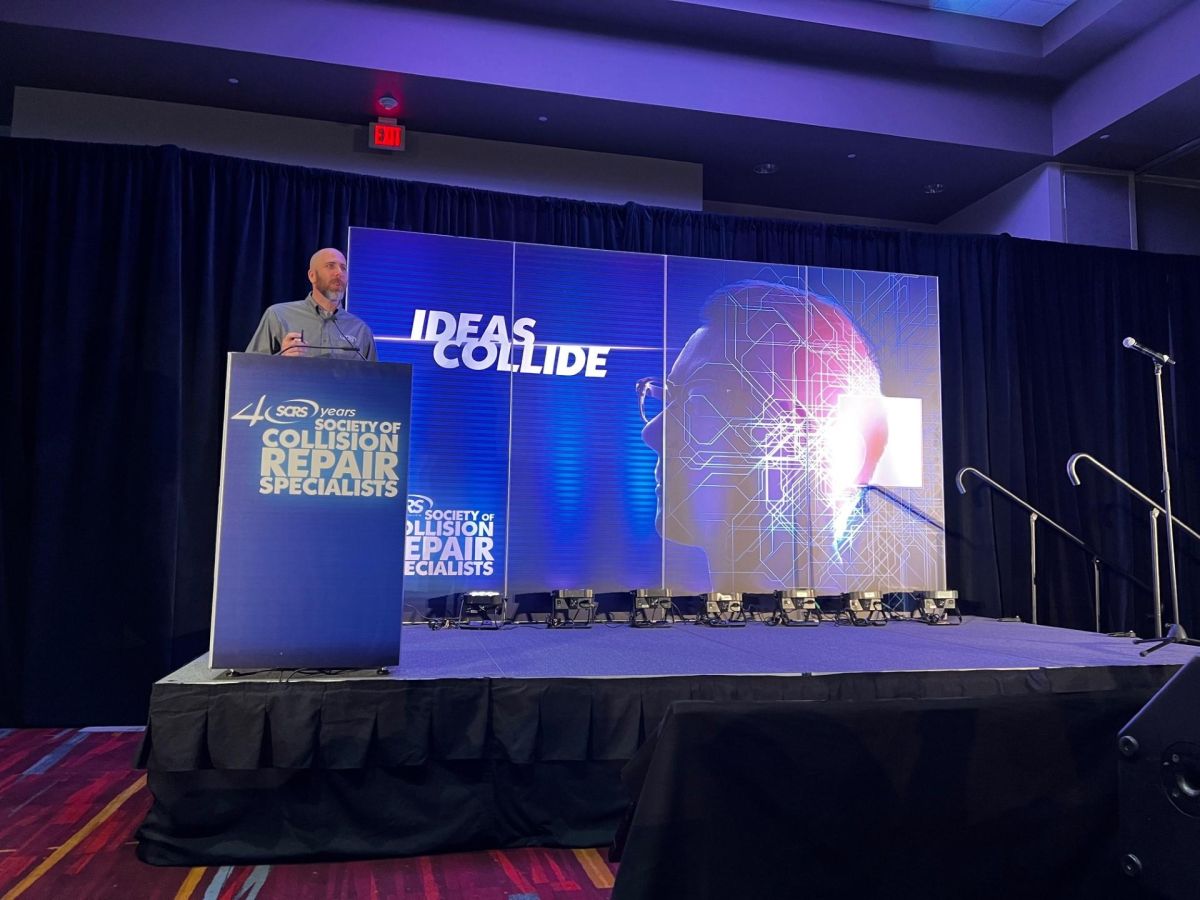This is the second part of a two-part article on the IDEAS Collide Showcase held during the 2023 SEMA Show. Read the first part here.
Collision repair professionals from a variety of backgrounds took part in the IDEAS Collide Showcase held during the 2023 SEMA Show in Las Vegas, NV. Participants shared their “grand schemes” for how the industry can improve and think differently. The presentations were part of the Society of Collision Repair Specialists (SCRS) Repairer Driven Education (RDE) Series.
Three are summarized below.
Death of the Estimator Role
Andrew Batenhorst, body shop manager at Pacific BMW in Glendale, CA, shared his perspective on the transition from estimator to repair planner. His talk was based on a longer presentation given that week as part of the SCRS RDE series: “Death of the Estimator Role.”
Batenhorst started his presentation by telling attendees they might not like what he had to say.
“I'm here to make you uncomfortable,” he said. “I'm here to make you question what we've been doing, and it has been long overdue.”
Batenhorst warned attendees about the problems the industry is facing with staffing shortages, needing to get paid more by bill payers and lack of a work-life balance.
“That is all due to the pervasive influence of the estimator role,” he noted. “It's time for it to change.”
Batenhorst said there are hundreds of estimator roles waiting to be filled.
“We’re unfortunately plagued with high turnover and we've become very complacent to it,” he said.
Looking back, Batenhorst said the Ford Taurus was a best-selling car in 1993. Fast forward to 2023, and Tesla was one of the top sellers.
“You can’t take the same mindset with assessing damage to that vehicle, understanding what it's made out of with the same lens that we've been using for the past 30 years,” Batenhorst pointed out. “The market has dictated these changes in automobiles, but still, the estimator role persists the way it has.”
With many estimators working an average of 10 or 12 hours a day, he said they are focusing on a variety of tasks, including checking in customers, scheduling, verifying insurance coverage, taking payments and delivering vehicles. This is resulting in burnout, high supplement rates, lengthy repairs and unhappy customers, among other challenges.
Instead, Batenhhorst said there are more valuable things they could be doing.
“It really has become a catch-all position in most modern body shops,” he said. “I challenge all of you to take a seat, watch what is going on and what they're doing throughout the day.”
Batenhorst said it's not too late to fix these problems. He shared a quote from Shigeo Shingo, one of the founders of the Toyota Production System: “The first step in improvement is dissatisfaction with the status quo.”
Later in the week, Batenhorst gave a presentation outlining a system for separating the estimator role and shifting to more thorough repair planning.
“I feel so strongly about this that I can't be the only guy doing this anymore,” he said. “I genuinely feel this will bring a lot of positive change to the industry.”
Growth Through Acquisition
Bing Wong, managing partner of Collision Builders, talked about the key things body shop operators need to know when considering growing their business through an acquisition. While many who talk about mergers and acquisitions focus on the larger consolidators, Wong said Collision Builders focuses on smaller operations, usually in the one- to five-store range, who face different challenges and opportunities in the marketplace.

For existing operators or senior managers with approximately 10 to 15 years of experience and planning the next step in their career, Wong encouraged them to consider an acquisition to help build the next generation of MSOs. He said an acquisition avoids many of the costs of starting from scratch, such as finding a lease, buying equipment, waiting on permits and contractors and hiring staff. Some upgrades and changes might be required; however, Wong pointed out most “decent shops” have several weeks of work booked out.
If the goal is to be part of a network, Wong said by purchasing an existing network shop, there won’t be any upfront franchise fees or rebranding costs. Many networks assist with providing additional acquisition opportunities and help with closing deals inside their networks.
Another benefit of pursuing an acquisition is the ability to integrate a competitor in a key territory, for example, in a more rural town with only a couple of locations. His team often sees great acquisition opportunities at affordable entry points in secondary and tertiary markets where the larger consolidators tend not to buy.
When looking for an acquisition, Wong recommended focusing on location, capacity, staff, reputation and network status.
“If you're a decent operator and buying a decent operation, you're going to keep most of the staff, OEM certifications and network status,” he noted.
Regarding pricing, Wong estimated set-up costs at the lower end of the market start around $250,000 in addition to the time it takes to upgrade the facility.
“They call this the ‘price-floor’ that you might expect to pay for a fully-equipped shop that is probably an owner-operator situation where the owner wants to retire and hasn’t invested too heavily in the latest equipment and training,” he said.
Wong said most deals are being sold for three to five times adjusted earnings; however, there are outliers above and below that range.
“If you were to ask me what kind of shop am I buying where I'm paying more than one-times sales, you're buying a premium OEM-certified facility with staff that has all of the latest training, and all key staff is staying on board,” he said.
When purchasing a shop under $2 million in sales, Wong said it’s likely a family business, where the owner/operator also paints some vehicles, may own the building and pay himself or herself rent and/or a salary, which might not show up in the financials.
“You've got to have somebody go through the normalization of earnings so you know what you're buying and there are no surprises,” he said.
For shops in the $3 million to $5 million range, Wong said potential buyers are likely competing with big consolidators and/or private equity-backed businesses.
“You need to understand how to come up with an offer quickly, whether you're paying a premium or a discount so you can compete in that environment against the bigger buyers,” he explained.
He also stressed the importance of determining financing.
Wong recommended shop owners refrain from spreading themselves too thin during the process, hire the proper counsel, and most importantly, not share the purchase plan with others.
“We’ve seen many deals go sour because the buyer or the seller couldn’t keep it a secret until the deal was done,” he said.
He closed the talk encouraging potential buyers to grow their collision portfolios and become the next generation of MSOs.
The Culture Code
Tracy Dombrowski, training manager at Collision Advice, talked about the importance of body shops building a strong culture in their businesses.
Dombrowski said a team at Harvard University chose 10 body shops and analyzed their culture over 10 years. They found the net revenue of the businesses with a strong culture outperformed those with a weak culture by 756%.
“That’s huge,” said Dombrowski. “The relationship between performance and culture is more than a mere coincidence, but implementing a strong culture in your business is not easy.”
 During her presentation, Dombrowski shared tips from a book by Daniel Coyle, "The Culture Code."
During her presentation, Dombrowski shared tips from a book by Daniel Coyle, "The Culture Code."First is to focus on safety and connection with teams.
“As adults, we want to feel safe and comfortable in the environments we work in,” she said. “If leaders have all the status and privilege in a business, they're unapproachable and we feel like we can't bring them our ideas.”
She said employees often don’t feel they can be candid when things aren't going well and don't take risks because they fear reprisals.
“Businesses that have a good, strong culture have a do it with them versus a do it to them approach and treat people with respect,” she noted. “They ask for their advice and opinions, and they include team members in decisions that impact them.”
Dombrowski stressed the importance of making sure everyone has a voice.
“Never end a meeting without everyone on your team having spoken, and thank people for their contributions, no matter how big or small,” she shared. “When they can do that, powerful things start to happen in your business.”
Step two is to share vulnerability.
“This means that the leader in a business is willing to admit their mistakes and ask for help,” she explained. “We all make mistakes and we all need help fixing them.”
Dombrowski said when a leader can share their weaknesses and vulnerabilities, teammates can put aside their insecurities and ask for help when needed.
The final point from Coyle's book is to talk about purpose. Dombrowski said this is a shared goal or vision for an organization that includes what you’ll do and why.
For example, body shop owners and managers often stress the importance of CSRs delivering extraordinary customer service. Dombrowski recommended letting them know why this is critical to the business that cares about customers and wants their lives to be better.
“If you can remember to give everyone a voice, share vulnerability, ask for help, admit your weaknesses and share that purpose with your team, then you'll be able to thrive and not just survive in your business,” she said.















Stacey Phillips Ronak